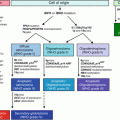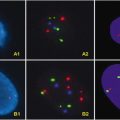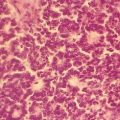11.
Kloppel G, Kosmahl M, Luttges J (2005) Intraductal neoplasms of the pancreas: cystic and common. Pathologe 26(1):31–36PubMed
12.
Canto MI et al (2004) Screening for pancreatic neoplasia in high-risk individuals: an EUS-based approach. Clin Gastroenterol Hepatol Off Clin Pract J Am Gastroenterol Assoc 2(7):606–621
13.
Sohn TA et al (2004) Intraductal papillary mucinous neoplasms of the pancreas: an updated experience. Ann Surg 239(6):788–797, discussion 797–9PubMed
14.
D’Angelica M et al (2004) Intraductal papillary mucinous neoplasms of the pancreas: an analysis of clinicopathologic features and outcome. Ann Surg 239(3):400–408PubMed
15.
Kimura W, Makuuchi M, Kuroda A (1998) Characteristics and treatment of mucin-producing tumor of the pancreas. Hepatogastroenterology 45(24):2001–2008PubMed
16.
Hruban RH et al (2001) Pancreatic intraepithelial neoplasia: a new nomenclature and classification system for pancreatic duct lesions. Am J Surg Pathol 25(5):579–586PubMed
17.
Hruban RH et al (2004) An illustrated consensus on the classification of pancreatic intraepithelial neoplasia and intraductal papillary mucinous neoplasms. Am J Surg Pathol 28(8):977–987PubMed
18.
Maitra A, Kern SE, Hruban RH (2006) Molecular pathogenesis of pancreatic cancer. Best Pract Res Clin Gastroenterol 20(2):211–226PubMed
19.
Almoguera C et al (1988) Most human carcinomas of the exocrine pancreas contain mutant c-K-ras genes. Cell 53(4):549–554PubMed
20.
Hruban RH et al (1993) K-ras oncogene activation in adenocarcinoma of the human pancreas. A study of 82 carcinomas using a combination of mutant-enriched polymerase chain reaction analysis and allele-specific oligonucleotide hybridization. Am J Pathol 143(2):545–554PubMed
21.
Hingorani SR, Tuveson DA (2003) Ras redux: rethinking how and where Ras acts. Curr Opin Genet Dev 13(1):6–13PubMed
22.
Calhoun ES et al (2003) BRAF and FBXW7 (CDC4, FBW7, AGO, SEL10) mutations in distinct subsets of pancreatic cancer: potential therapeutic targets. Am J Pathol 163(4):1255–1260PubMed
23.
Schutte M et al (1997) Abrogation of the Rb/p16 tumor-suppressive pathway in virtually all pancreatic carcinomas. Cancer Res 57(15):3126–3130PubMed
24.
Caldas C et al (1994) Frequent somatic mutations and homozygous deletions of the p16 (MTS1) gene in pancreatic adenocarcinoma. Nat Genet 8(1):27–32PubMed
25.
Russo AA et al (1998) Structural basis for inhibition of the cyclin-dependent kinase Cdk6 by the tumour suppressor p16INK4a. Nature 395(6699):237–243PubMed
26.
Liggett WH Jr, Sidransky D (1998) Role of the p16 tumor suppressor gene in cancer. J Clin Oncol Off J Am Soc Clin Oncol 16(3):1197–1206
27.
Redston MS et al (1994) p53 mutations in pancreatic carcinoma and evidence of common involvement of homocopolymer tracts in DNA microdeletions. Cancer Res 54(11):3025–3033PubMed
28.
Hermeking H et al (1997) 14-3-3 sigma is a p53-regulated inhibitor of G2/M progression. Mol Cell 1(1):3–11PubMed
29.
Chan TA et al (1999) 14-3-3Sigma is required to prevent mitotic catastrophe after DNA damage. Nature 401(6753):616–620PubMed
30.
Hahn SA et al (1996) DPC4, a candidate tumor suppressor gene at human chromosome 18q21.1. Science 271(5247):350–353PubMed
31.
Massague J, Blain SW, Lo RS (2000) TGFbeta signaling in growth control, cancer, and heritable disorders. Cell 103(2):295–309PubMed
32.
Siegel PM, Massague J (2003) Cytostatic and apoptotic actions of TGF-beta in homeostasis and cancer. Nat Rev Cancer 3(11):807–821PubMed
33.
Iacobuzio-Donahue CA et al (2000) Dpc4 protein in mucinous cystic neoplasms of the pancreas: frequent loss of expression in invasive carcinomas suggests a role in genetic progression. Am J Surg Pathol 24(11):1544–1548PubMed
34.
Wilentz RE et al (2000) Loss of expression of Dpc4 in pancreatic intraepithelial neoplasia: evidence that DPC4 inactivation occurs late in neoplastic progression. Cancer Res 60(7):2002–2006PubMed
35.
Koprowski H et al (1979) Colorectal carcinoma antigens detected by hybridoma antibodies. Somatic Cell Genet 5(6):957–971PubMed
36.
Locker GY, Hamilton S, Harris J, Jessup JM, Kemeny N, Macdonald JS, Somerfield MR, Hayes DF, Bast RC Jr, ASCO (2006) ASCO 2006 update of recommendations for the use of tumor markers in gastrointestinal cancer. Clin Oncol 24(33):5313–5327, Nov 20, Epub 2006 Oct 23
37.
Diamandis P, Hoffman BR, Sturgeon CM (2208) National academy of clinical biochemistry laboratory medicine practice guidelines for the use of tumor markers. Clin Chem 54(11):1935–1939
38.
Steinberg W (1990) The clinical utility of the CA 19–9 tumor-associated antigen. Am J Gastroenterol 85(4):350–355PubMed
39.
Goonetilleke KS, Siriwardena AK (2007) Systematic review of carbohydrate antigen (CA 19–9) as a biochemical marker in the diagnosis of pancreatic cancer. Eur J Surg Oncol J Eur Soc Surg Oncol Br Assoc Surg Oncol 33(3):266–270
40.
Duffy MJ (1998) CA 19–9 as a marker for gastrointestinal cancers: a review. Ann Clin Biochem 35(Pt 3):364–370PubMed
42.
Albert MB, Steinberg WM, Henry JP (1988) Elevated serum levels of tumor marker CA19-9 in acute cholangitis. Dig Dis Sci 33(10):1223–1225PubMed
43.
Takasaki H et al (1988) Correlative study on expression of CA 19–9 and DU-PAN-2 in tumor tissue and in serum of pancreatic cancer patients. Cancer Res 48(6):1435–1438PubMed
44.
Lindholm L, Johansson C, Jansson E-L, Hallberg C, Nilsson O (1985) An immunoradiometric assay (IRMA) for the CA-50 antigen. In: Holgren J (ed) Tumor marker antigen. Studentlitteratur, Lund, p 123
45.
Nilsson O et al (1992) Sensitivity and specificity of CA242 in gastro-intestinal cancer. A comparison with CEA, CA50 and CA 19–9. Br J Cancer 65(2):215–221PubMed
46.
Rothlin MA, Joller H, Largiader F (1993) CA 242 is a new tumor marker for pancreatic cancer. Cancer 71(3):701–707PubMed
47.
Kawa S et al (1994) Comparative study of CA242 and CA19-9 for the diagnosis of pancreatic cancer. Br J Cancer 70(3):481–486PubMed
48.
Haglund C et al (1994) CA 242, a new tumour marker for pancreatic cancer: a comparison with CA 19–9, CA 50 and CEA. Br J Cancer 70(3):487–492PubMed
49.
Ventrucci M et al (1998) Serum CA 242: the search for a valid marker of pancreatic cancer. Clin Chem Lab Med CCLM/FESCC 36(3):179–184
50.
Ozkan H, Kaya M, Cengiz A (2003) Comparison of tumor marker CA 242 with CA 19–9 and carcinoembryonic antigen (CEA) in pancreatic cancer. Hepatogastroenterology 50(53):1669–1674PubMed
51.
Eccleston DW et al (1998) Pancreatic tumour marker anti-mucin antibody CAM 17.1 reacts with a sialyl blood group antigen, probably I, which is expressed throughout the human gastrointestinal tract. Digestion 59(6):665–670PubMed
52.
Parker N et al (1992) A new enzyme-linked lectin/mucin antibody sandwich assay (CAM 17.1/WGA) assessed in combination with CA 19–9 and peanut lectin binding assay for the diagnosis of pancreatic cancer. Cancer 70(5):1062–1068PubMed
53.
Gansauge F et al (1996) CAM 17.1–a new diagnostic marker in pancreatic cancer. Br J Cancer 74(12):1997–2002PubMed
54.
Yiannakou JY et al (1997) Prospective study of CAM 17.1/WGA mucin assay for serological diagnosis of pancreatic cancer. Lancet 349(9049):389–392PubMed
55.
Rydlander L et al (1996) Molecular characterization of a tissue-polypeptide-specific-antigen epitope and its relationship to human cytokeratin 18. Eur J Biochem/FEBS 241(2):309–314
56.
Bjorklund B, Bjorklund V (1983) Specificity and basis of the tissue polypeptide antigen. Cancer Detect Prev 6(1–2):41–50PubMed
57.
Kornek G et al (1995) Tissue polypeptide-specific antigen (TPS) in monitoring palliative treatment response of patients with gastrointestinal tumours. Br J Cancer 71(1):182–185PubMed
58.
Banfi G et al (1993) Behavior of tumor markers CA19.9, CA195, CAM43, CA242, and TPS in the diagnosis and follow-up of pancreatic cancer. Clin Chem 39(3):420–423PubMed
Stay updated, free articles. Join our Telegram channel

Full access? Get Clinical Tree






